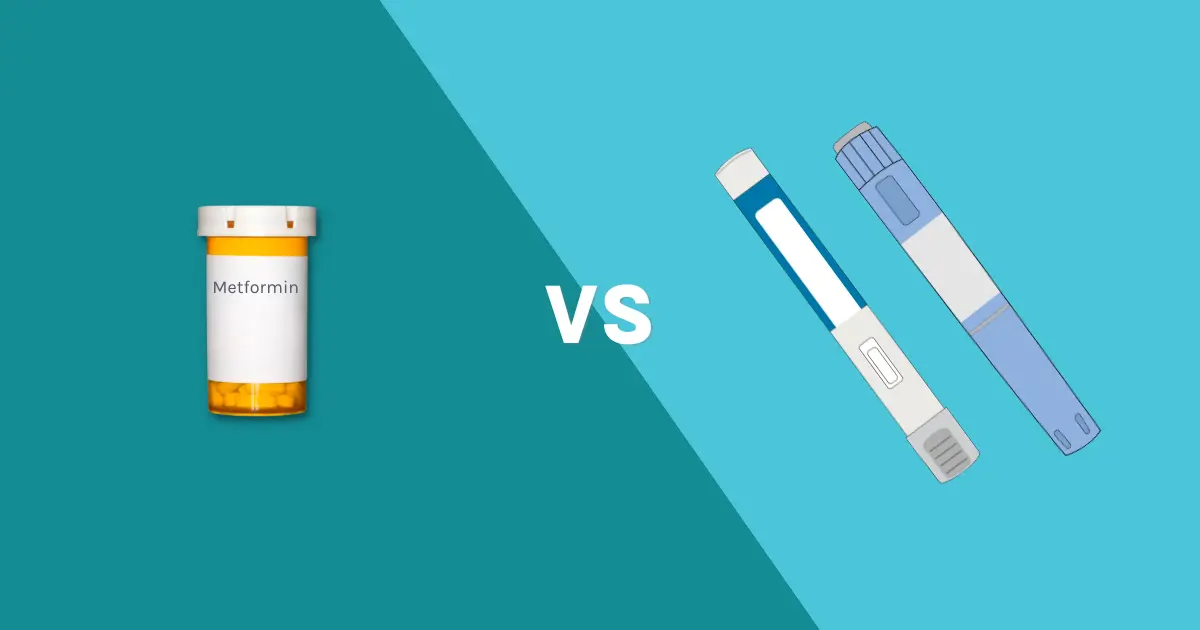Metformin vs. semaglutide: A detailed comparison for weight loss and diabetes
They both fight diabetes and help with weight loss, but in completely different ways. Get the clear breakdown.
Key highlights
- Metformin is a first-line oral medication for the management of type 2 diabetes. The medication is safe and has a low cost.
- Semaglutide is a GLP-1 agonist, available in three forms: Wegovy, Ozempic, and Rybelsus. The medication is used for the treatment of type 2 diabetes, weight management, and cardiovascular risk reduction.
- Combination therapy with metformin and semaglutide is often effective. The choice depends on blood sugar control, weight goals, comorbidities, cost, and individual tolerance.
- If you are newly diagnosed with type 2 diabetes, metformin is the treatment of choice. If blood glucose levels are uncontrolled with metformin, you can switch to semaglutide or use both medications as a combination therapy.
- If you aim to lose weight or reduce the risk of kidney or cardiovascular disease, semaglutide is more suitable as the medication is FDA-approved for this purpose.
Metformin has been the mainstay in type 2 diabetes treatment for many years. The medication lowers blood sugar levels by decreasing glucose production in the liver, enhancing insulin sensitivity, and improving glucose uptake by muscles. Metformin is the first-line medication for diabetes care, which is given as a long-term treatment. This medication comes in the form of oral tablets that are taken daily.
Semaglutide, available as Ozempic, Wegovy, and Rybelsus, is a newer medicine that has quickly gained attention for its ability to control blood sugar and support weight loss. Ozempic is FDA-approved for managing type 2 diabetes, lowering the risk of cardiovascular diseases, and preventing worsening kidney disease in patients with chronic kidney disease. Wegovy is indicated for managing body weight in obese and overweight patients with weight-related health problems and treating metabolic dysfunction-associated steatohepatitis (MASH) in patients with liver fibrosis. Rybelsus is available as oral tablets that are used for type 2 diabetes management. Ozempic is also used off-label for weight management.
Many people wonder how these two medications compare, since both are widely discussed in clinics and in everyday conversations about health. Both medicines are effective, but they work in different ways, have different indications, and side effects.
This guide explains the major differences and similarities, how each medication works, what benefits and risks to expect, and which patients may be the best fit for each. The goal is to give you clear information that can help you have an informed discussion with your healthcare provider.
Understanding how metformin works
Let’s explore how metformin works:
Drug class
Metformin belongs to a group of medicines called biguanides. This class of drugs works by lowering blood sugar levels in multiple ways, without stimulating the pancreas to make extra insulin. That is why metformin carries a very low risk of causing low blood sugar compared to other diabetes medicines.
Form
Metformin is taken as an oral tablet. It comes in an immediate-release (IR) and extended-release (ER) form. The immediate-release version is usually taken two to three times per day, while the extended-release form is taken once daily. Many patients find the extended-release version more convenient because it reduces the number of daily doses and has fewer gastrointestinal side effects.
Mechanism of action
Metformin targets three major pathways in the body:
- Liver: Metformin decreases glucose production in the liver. This process is called gluconeogenesis, and it is one of the key ways metformin lowers overall blood sugar levels.
- Muscle: Muscle is the main site where glucose is used for energy. Metformin makes muscle cells more sensitive to insulin, allowing more glucose to move from the bloodstream into the muscles.
- Fat: Fat tissue makes the body more resistant to insulin. Metformin helps fat cells respond more effectively to insulin, allowing glucose to be stored and used more healthily.
- Intestines: The intestines absorb glucose from food. Metformin slows this absorption, which helps prevent sudden spikes in blood sugar levels after meals.
Common uses
Metformin is the standard first-line treatment for type 2 diabetes worldwide. The medication is also used for prediabetes to lower the risk of developing type 2 diabetes and for polycystic ovary syndrome (PCOS), where it helps improve insulin resistance and may aid in restoring regular ovulation.
Typical dosage
Most people start with 500 milligrams once or twice a day. The dose can be gradually increased to a total of 2000 milligrams per day, depending on the patient’s blood sugar response and tolerance. Slow titration helps reduce stomach-related side effects.
Who it is for
Metformin can be prescribed for adults and for children aged 10 years or older. It is almost always the first prescription offered after lifestyle changes such as improved diet and exercise.
Understanding how semaglutide works
Drug class
Semaglutide is a GLP-1 receptor agonist, which means the medication mimics the action of the naturally occurring hormone glucagon-like peptide-1 and occupies its receptors in the brain, pancreas, and adipose tissues. This hormone is responsible for regulating appetite and blood sugar levels in the body. By mimicking its action, semaglutide suppresses appetite and promotes blood sugar control.
Form
Semaglutide is available in the form of injections and oral tablets. Ozempic is a weekly injection for diabetes, and Wegovy is a higher-dose injection for weight loss. Both of these medications are administered subcutaneously. Rybelsus is an oral form of semaglutide for diabetes that is available in the form of tablets (which are taken daily).
Mechanism of action
Semaglutide, an active ingredient in Ozempic, Wegovy, and Rybelsus, works in the following ways:
- Mimicking Natural Hormones: Semaglutide mimics the action of the GLP-1 hormone, a gut hormone that regulates appetite and blood glucose levels. The medication suppresses appetite and reduces hunger cravings, which helps lower food intake by occupying its receptors.
- Glucose-Dependent Insulin Release: Semaglutide stimulates the pancreas to release more insulin only when blood sugar levels are high and enhances the sensitivity of insulin, which promotes blood sugar control and prevents a rapid rise in blood glucose levels after meals.
- Glucagon Suppression: Semaglutide reduces glucagon secretion from the pancreas. Glucagon is responsible for raising blood sugar levels. Reduced glucagon production lowers blood sugar levels.
- Slowed Gastric Emptying: The medication slows digestion and delays how quickly food leaves the stomach, leading to prolonged feelings of fullness and reduced post-meal blood sugar spikes.
- Appetite Regulation: Semaglutide acts on the hunger control centre of the brain (lateral hypothalamus) that regulates appetite and suppresses appetite, which leads to reduced food intake and fewer hunger cravings.
Common uses
Semaglutide is indicated for managing type 2 diabetes, obesity, overweight, and weight-related health problems such as hypertension, high lipid levels, heart disease, and high cholesterol levels. Additionally, the medication is used for lowering the risk of metabolic dysfunction-associated steatohepatitis (MASH), cardiovascular diseases, and kidney failure.
Typical dosage
Typical dosage of semaglutide ranges between 0.25 mg to 2.4 mg weekly (in the form of subcutaneous injections).
Oral semaglutide dosage ranges between 3 mg and 14 mg.
Who it’s for
Semaglutide in the form of Rybelsus and Ozempic is used for adults with type 2 diabetes, while Wegovy is indicated for children over 12, adolescents, and adults for weight management.
Ideal candidates for semaglutide include:
- Adults with type 2 diabetes (Ozempic and Rybelsus)
- Adults who have established heart and blood vessel-related disease or those who are at risk of developing these diseases or heart failure (Ozempic)
- Adults with chronic kidney disease and type 2 diabetes, to reduce the risk of worsening kidney disease or end-stage renal disease (Ozempic)
- Children aged 12 or more, adolescents, and adults with obesity (BMI 30 or more) and overweight (BMI 27 or more) with at least one weight-related complication, such as hypercholesterolemia, hyperlipidemia, heart disease, and hypertension (Wegovy)
- Patients with metabolic dysfunction-associated steatohepatitis (MASH) in adults with moderate to advanced liver scarring or fibrosis, but they should not have cirrhosis (Wegovy)
Head-to-head comparison: Metformin vs. semaglutide
Metformin is the first-line therapy for type 2 diabetes. Semaglutide offers additional benefits, including weight loss as well as improvements in cardiovascular and kidney health.
Efficacy for blood sugar (HbA1c)
In clinical trials, metformin reduced HbA1c by 1%-2% or 11-22 mmol/mol and fasting blood glucose (FBG) by 2-3 mmol/L in patients with type 2 diabetes. Additionally, metformin reduced HbA1c by 1.5% (16 mmol/mol) and fasting blood glucose by approximately 3.1 mmol/L when titrated to 2000 mg/day for 6 months.
Semaglutide also reduces A1c by over 2.5-2.8%. No direct monotherapy trials compare the two, but separate data suggest similar benefits for blood sugar control.
In the SUSTAIN FORTE clinical trials, participants in the semaglutide (Ozempic) group showed an average reduction of 2.2 percentage points in the HbA1c levels with a 2 mg weekly dosage and 1.9 percentage points with a 1 mg weekly dosage of semaglutide after 40 weeks. Their body weight decreased by 6.9 kg and 6.0 kg with 2 mg and 1 mg of semaglutide, respectively.
Rybelsus lowered HbA1c by 1.0 to 1.3% with daily dosages of 7 mg and 14 mg, respectively, after 6 months in clinical trials.
Weight loss results
Metformin is not FDA-approved for weight management. Some patients, particularly those with insulin resistance or polycystic ovary syndrome, may see modest weight loss after using the medication for several months. A clinical study involved 154 patients with a body mass index ≥27 kg/m(2) who used metformin up to a dosage of 2,500 mg per day for 6 months. They showed a mean weight loss of 5.8-7.0 kg after 6 months.
Semaglutide promotes significant weight loss. In clinical trials, average reductions of 10-15% of body weight have been reported. Wegovy, an FDA-approved form of semaglutide, is indicated specifically for obesity management. In STEP clinical trials, adults without diabetes lost around 15% of body weight, and those with type 2 diabetes (STEP 2) lost about 9.6% of body weight over 68 weeks.
In the SUSTAIN FORTE clinical trials, adults with type 2 diabetes lost 6.9 kg with semaglutide 2·0 mg and 6·0 kg with semaglutide 1·0 mg after 40 weeks.
In the PIONEER1-4 and 8 trials, adults with type 2 diabetes lost more than 5% by the end of 26 weeks and more than 10% by the end of treatment with oral semaglutide (14 mg).
Primary indication and first-line status
Metformin is the usual first choice for adults newly diagnosed with type 2 diabetes, prescribed alongside lifestyle changes. Its long history of safe and effective use makes it the preferred starting point for most patients.
Semaglutide is often introduced when metformin alone is insufficient or when additional benefits, such as weight loss or protection for the heart and kidneys, are desired.
- Wegovy: Wegovy is approved for long-term weight management in adults with obesity or overweight with related health problems. In 2025, it also got approved for MASH (metabolic dysfunction-associated steatohepatitis).
- Ozempic: Ozempic is approved to treat type 2 diabetes and to lower the risk of heart attack, stroke, kidney disease progression, and death in people with diabetes and heart disease.
- Rybelsus: Rybelsus is approved to treat type 2 diabetes.
Cardiovascular and kidney considerations
Metformin has cardiometabolic benefits, but the medication does not have an FDA approval for cardiovascular or kidney protection. The decision between semaglutide and metformin often depends on comorbidities such as cardiovascular and renal disease.
Ozempic is FDA-approved for lowering the risk of heart attack, stroke, chronic kidney disease, and cardiovascular death in people with type 2 diabetes and heart disease.
The SELECT trial showed that Wegovy reduced major heart problems in adults with obesity and established heart disease. The SOUL trial showed heart benefits of Rybelsus in patients with diabetes and heart or kidney disease, though U.S. Food and Drug Administration (FDA) label expansion is still pending.
Dosing and delivery
Metformin is taken as an oral tablet, either in immediate-release or extended-release form, usually once or twice daily. The dose is often increased gradually to help reduce stomach side effects.
Metformin Immediate-release dosing schedule
- Initial dose: 500 mg twice a day or 850 mg once a day
- Titration phase: Increase in 500 mg increments every week or 850 mg every 2 weeks
- Maintenance dose: 2000 mg/day (In divided doses)
- Maximum dose: 2550 mg/day
Metformin Extended-release dosing schedule
- Initial dose: 500 to 1000 mg once a day
- Dose titration: Increase in 500 mg increments weekly according to the body’s tolerance
- Maximum dose: 2000 mg/day
Semaglutide is most often given as a once-weekly injection, either as Ozempic or Wegovy. It is also available as Rybelsus, a once-daily oral tablet that must be taken on an empty stomach with water, at least 30 minutes before eating or drinking.
Ozempic dosing schedule
- Weeks 1-4: 0.25 mg once weekly
- Weeks 5-8: 0.5 mg once weekly
- Weeks 9-12: 1 mg once weekly if more blood sugar control is needed
- Week 13 onward: 2 mg once weekly if tolerated and further control is required
Wegovy dosing schedule
- Weeks 1-4: 0.25 mg once weekly
- Weeks 5-8: 0.5 mg once weekly
- Weeks 9-12: 1 mg once weekly
- Weeks 13-16: 1.7 mg once weekly if tolerated
- Week 17 onward: 2.4 mg once weekly as the full maintenance dose
Rybelsus dosing schedule
There are two formulations of Rybelsus. Both have different dosing schedules.
Formulation R1 (3 mg, 7 mg, 14 mg)
- Weeks 1-4: 3 mg once daily (starting dose, not effective for blood sugar control)
- Weeks 5-8: 7 mg once daily
- Week 9 onward: Stay on 7 mg if effective, or increase to 14 mg once daily if more control is needed
Formulation R2 (1.5 mg, 4 mg, 9 mg)
- Weeks 1-4: 1.5 mg once daily
- Weeks 5-8: 4 mg once daily
- Week 9 onward: Stay on 4 mg if effective, or increase to 9 mg once daily if more control is needed
Who can use it?
Metformin can be used in children aged 10 years and older as well as adults. Semaglutide is primarily approved for adults, with Ozempic and Rybelsus used for the treatment of type 2 diabetes, and Wegovy used for the management of obesity.
Wegovy is also approved for children over 12 years, adolescents, and older adults with obesity. Both medicines should be stopped in women who are planning pregnancy, since semaglutide is not recommended during conception or pregnancy.
Long-term benefits
Metformin does not have an FDA approval for cardiovascular protection, but the medication has metabolic benefits. It is also used off-label for prediabetes and polycystic ovary syndrome.
Semaglutide is FDA-approved to lower the risk of heart attack, stroke, and cardiovascular death in adults with type 2 diabetes and cardiovascular disease. The medication also slows the progression of kidney disease.
Cost and accessibility
Metformin is widely available as a generic and is very affordable, often less than $10 per month at retail pharmacies. On the other hand, semaglutide is a brand-name medication and is more expensive.
Ozempic costs approximately $800 to $1,300 per month, Wegovy costs over $1000 to $1,300, and Rybelsus costs between $850 and $1,000. Some patients using Wegovy or Ozempic may be eligible for savings programs that reduce the monthly cost to as little as $0-25 per month with commercial insurance coverage, or $499 per month without insurance coverage.
Semaglutide retail prices
| Pharmacy | Ozempic | Wegovy | Rybelsus |
|---|---|---|---|
| Walgreens | $995 | $1,390 | $1,030.63 |
| Walmart | $995 | $1,447 | $1,071.43 |
| CVS Pharmacy | $995 | $1,390 | $1,033.85 |
| Costco | $964.99 | $1,425 | $1,425 |
Side effects profile: Metformin vs. semaglutide
Both metformin and semaglutide frequently cause side effects, especially at the start of treatment or when doses are increased.
Common side effects for both medications
Both medicines frequently cause gastrointestinal side effects. These side effects can be minimized or avoided with low starting doses, slow titration, and dietary adjustments such as smaller meals and limiting high-fat foods. Common side effects for both include:
- Nausea
- Vomiting
- Diarrhea
- Abdominal pain
- Abdominal discomfort
- Constipation
Metformin side effects
Metformin is usually well tolerated, but some less common side effects can occur. Some patients may notice:
- A metallic taste in the mouth, which often improves with continued use.
- A mild decrease in appetite may appear, although it is usually subtle.
- Headache or dizziness can occur in some patients, and these symptoms often resolve with time.
- Increased sweating may be reported, particularly at higher doses.
Semaglutide side effects
All three brands of semaglutide share a similar gastrointestinal side effect profile, although rates vary by brand and dose.
Semaglutide side effects
| Wegovy | In clinical trials, patients who received 2.4 mg of Wegovy once a week experienced the following side effects. Nausea was reported in 44% compared with 16% on placebo. Diarrhea occurred in about 30% compared with 16% on placebo. Vomiting was reported in 25% compared with 6% on placebo. Constipation was observed in 24% of patients, compared with 11% on placebo. Most side effects were mild and improved over time, but approximately 4% of patients discontinued treatment due to stomach problems. |
| Ozempic | In the SUSTAIN trials, patients received doses ranging from 0.5 mg to 2 mg once a week as an injection. The participants went through: Nausea was reported in 15-20% of cases. Diarrhea was seen in about 9% of cases. Abdominal pain was reported in 6 to 7% of cases. Constipation occurred in 3-5% of cases. These effects were most common during dose increases, and approximately 3 to 4% of patients discontinued the medication for this reason. |
| Rybelsus | In clinical trials, patients received doses of 7 mg to 14 mg daily as an oral tablet. Nausea was reported in 11 to 20% of patients. Diarrhea occurred in 9 to 10% of patients. Vomiting was seen in 6 to 8% of patients. Constipation (5-6%), stomach pain, and indigestion were reported in 5 to 10% of patients. These side effects appeared mostly at the beginning of treatment, when patients first started taking the tablets. |
Serious risks
Every medication has benefits as well as risks, and both metformin and semaglutide are no exception. Each carries rare but serious safety concerns, and there are clear situations where they should not be used.
Metformin:
Lactic acidosis is the most serious risk of metformin, but it is extremely rare. The condition causes a build-up of lactic acid in the blood that the body cannot clear. If it develops, its symptoms include nausea, vomiting, confusion, rapid breathing, abdominal pain, and muscle pain or weakness.
Long-term use of metformin can lower vitamin B12 levels in some patients. The risk increases with longer term use of the medication. Symptoms of vitamin B12 deficiency are fatigue, tingling, numbness in the hands and feet, and anemia.
Semaglutide:
The following are rare but serious side effects of semaglutide:
- Thyroid C-Cell Tumors: Semaglutide has a boxed warning for thyroid tumors based on animal studies. A few rodent studies showed that this medication increased the risk of thyroid cancer. The risk in humans is still unknown. The medication is contraindicated in patients with a personal or family history of medullary thyroid carcinoma (MTC) or Multiple Endocrine Neoplasia syndrome type 2 (MEN 2).
- Pancreatitis: Some patients report inflammation of the pancreas, also known as pancreatitis, after taking semaglutide. Symptoms of pancreatitis include upper abdominal pain that radiates to the back, fever, abdominal tenderness, nausea, and vomiting.
- Gallbladder Issues: Semaglutide is also known to cause gallstones or gallbladder inflammation. Symptoms of gallbladder inflammation are jaundice, fever, right upper abdominal pain, nausea, vomiting, fever, and chills.
- Ileus/Bowel Obstruction: As semaglutide delays gastric emptying, it can cause GI motility issues such as ileus or bowel obstruction.
- Increased risk of aspiration: Semaglutide increases the risk of aspiration during sedation and anesthesia.
- Diabetic retinopathy: Semaglutide may cause vision changes or worsen diabetic retinopathy.
Hypoglycemia risk
Metformin alone has a very low risk of hypoglycemia. In the longstanding UKPDS trial, metformin did not increase the rate of hypoglycemia compared with diet therapy. When it comes to semaglutide, clinical trial data show that Wegovy caused hypoglycemia in 6% of patients compared to 2% patients in the placebo group. Ozempic showed low hypoglycemia risk as monotherapy. Most cases occurred only when it was administered along with metformin and insulin. Rybelsus also had low rates of hypoglycemia in patients with type 2 diabetes mellitus. Risk was higher only in those patients who used it alongside insulin or sulfonylureas.
Semaglutide vs. metformin side effects comparison
| Ozempic (s.c. semaglutide) | Wegovy (s.c. semaglutide 2.4 mg) | Rybelsus (oral semaglutide) | Metformin | |
|---|---|---|---|---|
| Drug class | GLP-1 receptor agonist | GLP-1 receptor agonist | GLP-1 receptor agonist (oral) | Biguanide |
| Mechanism of action | Mimics GLP-1 to increase glucose-dependent insulin secretion, decrease glucagon, slow gastric emptying, and reduce appetite | Same as Ozempic but at a higher dose for weight management | Same GLP-1 effects as Ozempic and Rybelsus | Decreases hepatic glucose production, increases insulin sensitivity, and improves peripheral glucose uptake |
| Form & frequency | Subcutaneous injection, once weekly | Subcutaneous injection, once weekly (higher maintenance dose for weight loss) | Oral tablet, once daily (must be taken on an empty stomach with water) | Oral tablet: immediate-release usually twice daily, extended-release once daily |
| Typical A1C reduction | About 1.4–1.9% depending on dose and study | Lowers A1C in people with diabetes, main indication is weight loss | About 1.0–1.5% depending on dose (based on PIONEER trials) | About 1.0–1.2% as monotherapy on average |
| Typical weight loss | Weight loss of about 6.5 kg (real-world data) | Significant (about 10–15% body weight reduction in obesity trials) | weight loss of about 5.9 kg (real-world data) | 5.8-7.0 kg after 6 months with the dosage of up to 2500 mg per day. |
| Cardio-renal evidence | Reduces major cardiovascular events by 26% in patients with cardiovascular disease | SELECT and STEP trials showed reduced cardiovascular events in obesity populations | PIONEER 6 demonstrated cardiovascular safety, not approved for cardiovascular risk red | UKPDS and follow-up data suggest long-term cardiovascular benefit,but not FDA approved for cardiovascular risk reduction |
| Common GI side effects | Nausea, vomiting, diarrhea, constipation, abdominal pain | Nausea, vomiting, diarrhea, constipation, dyspepsia (higher dose increases frequency) | Nausea, diarrhea, vomiting, decreased appetite, abdominal discomfort | Diarrhea, nausea, abdominal bloating (improved with extended-release forms) |
| Unique risks or cautions | Reports of pancreatitis, gallbladder disease, and thyroid C-cell tumors (in rodents); hypoglycemia when used with insulin or sulfonylureas | Similar class warnings as Ozempic, more GI intolerance at higher doses | Similar class warnings, must be taken correctly to ensure absorption, may interact with other oral drugs | Rare lactic acidosis (mainly in renal impairment), possible vitamin B12 deficiency with long-term use |
| Age approvals | Adults with type 2 diabetes | Adults and adolescents aged 12 years and older for weight management | Adults with type 2 diabetes | Adults and children aged 10 years and older |
| Cost and access | Brand only (Novo Nordisk), no generic injectable semaglutide currently available | Brand only (Wegovy by Novo Nordisk), insurance coverage variable | Brand only (Rybelsus by Novo Nordisk), no generics available | Widely available generic, very low cost and high accessibility |
Can you take both medications together?
Metformin and semaglutide are often prescribed together as they have complementary mechanisms.
Synergistic effects
Clinical evidence shows that combining metformin with semaglutide provides stronger benefits, such as better blood sugar control and weight management, than using either medicine alone. A recent analysis confirmed that the combination leads to greater improvements in blood sugar control, along with added weight loss.
A STEP 2 trial involved more than 1,210 adults with type 2 diabetes who were already taking a glucose-lowering agent such as metformin or sulfonylurea. After 68 weeks, semaglutide 2.4 mg showed an average weight loss of 9.6% and superior HbA1c reductions compared to the placebo.
Risks and considerations
When you use both medications together, you need to monitor certain risks more carefully. The following are the risk factors and considerations of using both medications simultaneously:
- Monitor your blood glucose levels closely because the chance of hypoglycemia increases when you combine these medications.
- Your doctor will regularly check your kidney function, including eGFR and creatinine, because reduced kidney function increases the risk of lactic acidosis with metformin. Additionally, dehydration from nausea or vomiting can exacerbate this condition.
- Your doctor may ask you to get your Vitamin B12 levels tested periodically because long-term use of metformin can lower B12 levels, leading to symptoms such as tiredness, numbness, or anemia.
- Track your weight changes and HbA1c levels to assess the effectiveness of the combination therapy and to lower the risk of hypoglycemia.
- Nausea, vomiting, and diarrhea are common with both medications. If you experience persistent discomfort, consult your healthcare provider. They will make necessary dose adjustments. In case of intolerable side effects, they may switch to other GLP-1 medications, such as liraglutide, tirzepatide (Mounjaro or Zepbound), or dulaglutide.
- If you develop any symptoms of thyroid tumor, your doctor will stop the medication, as semaglutide is not recommended for individuals with a personal or family history of medullary thyroid carcinoma or Multiple Endocrine Neoplasia type 2.
Who should choose metformin or semaglutide?
The decision between metformin and semaglutide depends on your specific medical needs and health goals.
If you’re newly diagnosed with type 2 diabetes
Healthcare providers almost always begin treatment with metformin, alongside lifestyle changes such as diet and exercise. This is referred to as first-line therapy because metformin is safe, affordable, and has been proven effective through decades of research.
Large studies, such as the UKPDS trial, have shown that people starting with metformin have better blood sugar control and fewer long-term complications.
If weight loss is a priority
Semaglutide is FDA-approved for managing weight in patients with obesity and overweight. The medication promotes significant weight loss. If weight loss is your priority, choose semaglutide.
In the STEP 2 trial, patients with type 2 diabetes who took semaglutide 2.4 mg lost nearly 9.6% of their body weight over 68 weeks, compared with approximately 3% on placebo. These results show that semaglutide is a better option for managing obesity and overweight.
If you have uncontrolled blood sugar levels
Semaglutide is often the preferred option when metformin alone is not enough to meet HbA1c targets. A combination of semaglutide and metformin also promotes better glycemic control.
If you have heart or kidney concerns
Semaglutide is suitable for patients with type 2 diabetes who also have heart disease or chronic kidney disease. The SUSTAIN 6 trial showed a reduction in major cardiovascular events, while the FLOW trial demonstrated slower progression of kidney disease.
If cost and convenience are the most important considerations
Metformin remains the go-to therapy because it is inexpensive, simple, and widely available as a generic pill for under $10 a month. Semaglutide is a brand-only medication priced at around $800 to $1,300 or more per month without insurance. In addition, the brand name Rybelsus requires strict timing instructions.
If you prefer a weekly injection over daily pills
Semaglutide may be the better fit for people who want a weekly injection instead of taking daily pills. Ozempic and Wegovy are given once a week, while Rybelsus is a once-daily oral option.
Who should not take metformin or semaglutide
Although semaglutide and metformin are effective, both should be avoided in certain populations.
| Do not take metformin if you have: | Do not take semaglutide if you have: |
|---|---|
| Severe kidney disease with very low eGFR Advanced liver disease Severe heart failure An acute illness that raises the risk of lactic acidosis, such as: Sepsis (serious infection) Shock (very low blood pressure and poor circulation) Severe dehydration | A personal or family history of medullary thyroid carcinoma (MTC) or Multiple Endocrine Neoplasia syndrome type 2 (MEN 2) A past severe allergic reaction to semaglutide Severe gastrointestinal disease, such as gastroparesis Active pancreatitis Pregnancy, breastfeeding, or planning pregnancy soon |
Long-term tips for success
Follow these tips for long-term results:
- Be patient and consistent: Managing type 2 diabetes and weight is not an overnight process. It takes time and consistency to get sustainable results.
- Use medication as a support, not a shortcut: Metformin and semaglutide can help improve blood sugar and weight, but they work best alongside healthy habits. Exercise daily and increase your physical activity along with dietary modifications to get the best results.
- Prioritize nutrition: Choose balanced meals with lean proteins, fiber, and limited refined carbs. Focus on portion control and consistent meal timing.
- Stay active: Aim for at least 150 minutes of moderate exercise per week. Walking, swimming, or strength training all help improve insulin sensitivity and support weight loss.
- Get enough sleep: Quality sleep regulates hormones that affect appetite, metabolism, and glucose control. Get at least 8-9 hours of sleep daily.
- Stick with your treatment plan: Long-term therapy and regular follow-ups are necessary for long-term results. Stay in touch with your doctor for dose adjustments and managing side effects. Follow your treatment plan and medical advice strictly to get the best results.
- Avoid abrupt discontinuation: Do not stop the medication abruptly, as stopping medication without lifestyle adjustments can cause blood sugar spikes or weight gain.
- Monitor progress: Keep a journal or app to track blood glucose levels, weight changes, and side effects. Show them to your doctor on your next visit.
- Build sustainable habits: Focus on small, realistic changes you can maintain for life rather than short-term fixes.
Starting metformin smoothly
- Begin with a low dose and increase gradually.
- Consider the extended-release form to reduce stomach upset.
- Take doses with food for better tolerance.
- Check vitamin B12 levels periodically with long-term use.
Starting semaglutide smoothly
- Start at a low dose and escalate gradually to improve tolerability.
- Stay hydrated and eat in smaller portions but more frequently. Prioritize foods rich in protein and dietary fiber in your meals.
- Limit alcohol intake and avoid heavy, fatty foods.
- Follow your clinician’s guidance during dose adjustments.
Monitor and follow up
- Check HbA1c about every 3 months when adjusting treatment.
- Track your blood sugar levels, weight, waist size, and blood pressure regularly.
- Get your kidney function regularly tested for regular monitoring.
- Monitor vitamin B12 levels during long-term metformin therapy.
FAQs
Can semaglutide replace metformin?
Metformin remains the first-line treatment for most people with newly diagnosed type 2 diabetes because it is safe, effective, and inexpensive. Semaglutide is typically used if more blood sugar control or weight loss is required, or if benefits for the heart or kidneys are a priority.
Which causes more stomach issues?
Both medications can cause stomach issues, especially when starting treatment. However, semaglutide has a greater risk of stomach and gastrointestinal issues compared with metformin.
Is semaglutide worth the cost?
Although semaglutide is expensive, the medication is worth the cost. It offers additional benefits, such as promoting greater weight loss, reducing cardiovascular risks, treating liver fibrosis, and preventing kidney failure.
Conclusion: Is metformin or semaglutide right for you?
Metformin is the first-line treatment for type 2 diabetes because it’s a safe, affordable, and effective medication. Semaglutide is used when blood sugar levels are still uncontrolled with traditional medications as it promotes greater reduction in HbA1c levels, has weight loss benefits, and reduces the risk of heart and kidney diseases. Both medicines work in different ways and can even be used together.
If you are newly diagnosed with diabetes, your doctor will most likely recommend metformin. If you have been taking metformin but your blood sugar levels are still uncontrolled, or you want additional benefits such as weight reduction, cardiovascular risk reduction, or kidney protection, semaglutide alone or as a combination therapy with metformin is suitable for you.
The choice of the right diabetes medication depends on your health needs, medical history, and priorities. The decision of taking metformin or semaglutide alone or as a combination therapy is highly personal. Consult your healthcare professional to discuss the pros and cons of these treatment options, your health goals, and preferences to make an informed decision.






